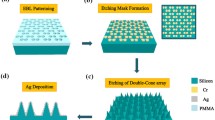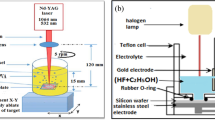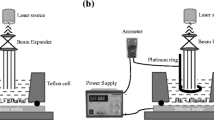Abstract
The composite structure of nano-porous anodic alumina (nano-PAA) coated with noble metal layer has been demonstrated to be one kind of high-sensitive surface-enhanced Raman scattering (SERS)-active substrate. However, the experimental investigations on influences of parameters were restricted by correlation between variables. And in relevant simulation studies, nano-tips at intersections of unit edges on the surface and the metal attaching to inside walls of nano-holes which are crucial for the enhancement of electric field were commonly idealized. To obtain the optimal structure of nano-PAA-Au array for SERS applications, numerical evaluations of the electric field distributions and intensities at hotspots were carried out on a proposed precise model. The influence of structure and excitation parameters which determined the electromagnetic enhancement have been systematically investigated. The numerical data shows that the intensity and distribution of surface electric field is evidently affected by both the characteristics of nano-tips and the metal attaching to the inside wall of holes. In addition, the designed substrate was synthesized accordingly and demonstrated to be higher sensitive with an achieved enhancement factor of 1.04 × 107. The study would be helpful in designing high-sensitive SERS-active substrates.






Similar content being viewed by others
References
Kneipp K, Wang Y, Kneipp H, Perelman LT, Itzkan I (1997) Single molecule detection using surface-enhanced Raman scattering (SERS). Phys Rev Lett 78(9):1667–1670
Nie S, Emory SR (1997) Probing single molecules and single nanoparticles by surface-enhanced Raman scattering. Science 275(5303):1102–1106
Khlebtsov BN, Khanadeev VA, Panfilova EV, Bratashov DN, Khlebtsov NG (2015) Gold nanoisland films as reproducible SERS substrates for highly sensitive detection of fungicides. ACS Appl Mater Interfaces 7(12):6518–6529
Hering K, Cialla D, Ackermann K, Dörfer T, Möller R, Schneidewind H, Mattheis R, Fritzsche W, Rösch P, Popp J (2008) SERS: a versatile tool in chemical and biochemical diagnostics. Analytical & Bioanalytical Chemistry 390(1):113–124
Halvorson RA, Vikesland PJ (2010) Surface-enhanced Raman spectroscopy (SERS) for environmental analyses. Environmental Science & Technology 44(20):7749–7755
Kerker M (1984) Electromagnetic model for surface-enhanced Raman scattering (SERS) on metal colloids. Accchemres 17(8):271–277
Xu H, Aizpurua J, Kall M, Apell P (2000) Electromagnetic contributions to single-molecule sensitivity in surface-enhanced Raman scattering. Physical Review E Statistical Physics Plasmas Fluids & Related Interdisciplinary Topics 62(3 Pt B):4318–4324
Lee SJ, Guan Z, Xu H, Moskovits M (2007) Surface-enhanced Raman spectroscopy and nanogeometry: the plasmonic origin of SERS. J Phys Chem C 111(49):17985–17988
Le F, Brandl DW, Urzhumov YA, Wang H, Kundu J, Halas NJ, Aizpurua J, Nordlander P (2008) Metallic nanoparticle arrays: a common substrate for both surface-enhanced Raman scattering and surface-enhanced infrared absorption. ACS Nano 2(4):707–718
Tripp RA, Dluhy RA, Zhao Y (2008) Novel nanostructures for SERS biosensing. Nano Today 3(3–4):31–37
Song J, Xian J, Yu M, Wang D (2015) Ultrahigh enhancement factor by using a silver nanoshell with a gain core above a silver substrate for surface-enhanced Raman scattering at the single-molecule level. IEEE Photonics Journal 7(5):1–8
Cho WJ, Kim Y, Jin KK (2011) Ultrahigh-density array of silver nanoclusters for SERS substrate with high sensitivity and excellent reproducibility. ACS Nano 6(1):249–255
Zhou L, Li M, Tang L, He JJ, Zhou L, Li M, Tang L, He JJ (2016) Gold/silicon nanowire arrays modified by gold nanosphere as the surface-enhanced Raman spectroscopy substrate. J Phys Conf Ser 680:012003
Sinha G, Depero LE, Alessandri I (2011) Recyclable SERS substrates based on Au-coated ZnO nanorods. ACS Appl Mater Interfaces 3(7):2557–2563
Das G, Patra N, Gopalakrishnan A, Zaccaria RP, Toma A, Thorat S, Di FE, Diaspro A, Salerno M (2012a) Fabrication of large-area ordered and reproducible nanostructures for SERS biosensor application. Analyst 137(8):1785–1792
Yongwen T, Jiajun G, Wei X, Zhipeng C, Dingxin L, Qinglei L, Di Z (2013) Reduction of CuO butterfly wing scales generates Cu SERS substrates for DNA base detection. ACS Appl Mater Interfaces 5(20):9878–9882
Sui C, Wang K, Wang S, Ren J, Bai X, Bai J (2016) SERS activity with tenfold detection limit optimization on a type of nanoporous AAO-based complex multilayer substrate. Nanoscale 8(11):5920–5927
Nielsen P, Hassing S, Albrektsen O, Foghmoes S, Morgen P (2009) Fabrication of large-area self-organizing gold nanostructures with sub10 nm gaps on a porous Al 2 O 3 template for application as a SERS-substrate. J Phys Chem C 113(32):14165–14171
Dukhyun C, Yeonho C, Hong S, Kang T, Lee LP (2010) Self-organized hexagonal-nanopore SERS array. Small 6(16):1741–1744
Das G, Patra N, Gopalakrishanan A, Zaccaria RP, Toma A, Thorat S, Fabrizio ED, Diaspro A, Salerno M (2012b) Surface enhanced Raman scattering substrate based on gold-coated anodic porous alumina template. Microelectron Eng 97(3):383–386
Malek K, Brzózka A, Rygula A, Sulka GD (2014) SERS imaging of silver coated nanostructured Al and Al 2 O 3 substrates. The effect of nanostructure. J Raman Spectrosc 45(4):281–291
Toccafondi C, Zaccaria RP, Dante S, Salerno M (2016) Fabrication of gold-coated ultra-thin anodic porous alumina substrates for augmented SERS. Materials 9(6):403
Chamuah N, Nath P (2015) Periodically varying height in metal nano-pillars for enhanced generation of localized surface plasmon field. Plasmonics 10(6):1–6
Shan D, Huang L, Li X, Zhang W, Wang J, Cheng L, Feng X, Liu Y, Zhu J, Zhang Y (2014) Surface plasmon resonance and interference coenhanced SERS substrate of AAO/Al-based Ag nanostructure arrays. J Phys Chem C 118(41):23930–23936
Hildebrandt P, Stockburger M (1984) Surface-enhanced resonance Raman spectroscopy of rhodamine 6G adsorbed on colloidal silver. J Phys Chem 88(24):5935–5944
Kudelski A (2005) Raman studies of rhodamine 6G and crystal violet sub-monolayers on electrochemically roughened silver substrates: do dye molecules adsorb preferentially on highly SERS-active sites? Chem Phys Lett 414(4):271–275
Acknowledgements
This project is supported by the National Natural Science Foundation of China (Grant No. 61378083), the International Cooperation Foundation of the National Science and Technology Major Project of the Ministry of Science and Technology of China (Grant No. 2011DFA12220), the Major Research Plan of the National Natural Science Foundation of China (Grant No. 91123030), the Key Laboratory Project of Shaanxi Education Department (Grant Nos. 14JS106 and 16JS102), the Natural Science Foundation of Shaanxi Province (Grant No. 2010JS113), and the Major Fundamental Research Project of Natural Science Fundamental Research Program of Shaanxi Province (Grant No. 2016ZDJC-15).
Author information
Authors and Affiliations
Corresponding author
Additional information
Chaofan Sui and Wenxuan Zhao are co-first authers of this article.
Rights and permissions
About this article
Cite this article
Sui, C., Zhao, W., Wang, K. et al. Studying Properties of Composite Nano-PAA-Au Array for the Optimal SERS Sensitivity. Plasmonics 13, 631–638 (2018). https://doi.org/10.1007/s11468-017-0554-9
Received:
Accepted:
Published:
Issue Date:
DOI: https://doi.org/10.1007/s11468-017-0554-9




